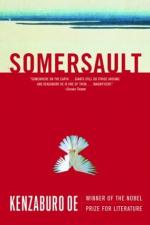|
This section contains 871 words (approx. 3 pages at 300 words per page) |

|
SOURCE: Rubin, Merle. “A Portrait of a Woman Who Transcends Culture.” Christian Science Monitor 88, no. 143 (19 June 1996): 14.
In the following review, Rubin praises Ōe's multi-layered portrayal of Marie Kuraki, the protagonist of An Echo of Heaven.
Awarded the Nobel Prize for Literature in 1994, Japan's Kenzaburo Oe has distinguished himself not only as an innovative artist but also as a voice for humanitarian values. He consistently tackles difficult and troubling subjects without flinching, but with an attitude of careful deliberation and open-mindedness, whether he is dealing with the dehumanizing effects of war (as in his novel Nip the Buds, Shoot the Kids) or the anguish of a parent of a handicapped child (as in The Silent Cry).
A child of World War II and the father of a retarded son, Oe tends to write about what he has experienced. In An Echo of Heaven (published in Japan in 1989, appearing now...
|
This section contains 871 words (approx. 3 pages at 300 words per page) |

|


